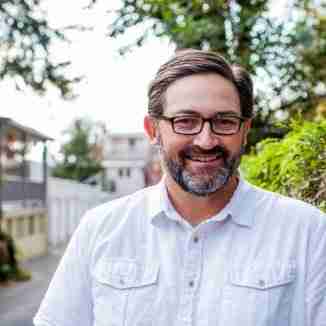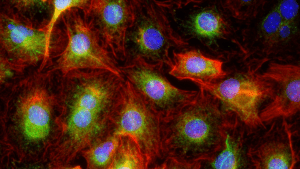
What Does It Take to Build A Globally Competitive Biohealth Cluster?
The Key Elements That Are Making the BioHealth Capital Region A Premier Global Destination for BioHealth Companies
The BioHealth Capital Region (BHCR) continues to thrive and currently occupies the fourth spot in the most recent Genetic Engineering & Biotechnology (GEN) top ten U.S. biohealth cluster rankings. More importantly, the collaborative efforts across industry, academia, government and nonprofits within the BHCR have generated powerful momentum that is now producing tangible results: The region has moved up two spots in GEN’s rankings in the last five years.
Myriad factors determine a cluster’s overall GEN ranking, including NIH funding, venture capital funding, patents, lab space and jobs. While GEN isn’t the only biocluster ranking system, GEN’s rubric is data-driven and has been consistently applied since 2014. GEN’s ranking system takes into account a complex, variegated mix of cluster elements that are subject to many forces and influences. While GEN’s ranking criteria touch on key elements that create a top-tier biohealth cluster, each cluster is unique in its advantages and challenges.
Gaining a broader understanding of the key elements that build a top-tier biohealth cluster, and how they are being addressed in the BHCR, is essential to comprehending how the region is evolving to meet its goal of becoming “Top 3 by 2023.”
Clearly, there is a lot of excitement and optimism about where the BHCR is and where it could go in the next decade. There is so much potential, only some of which has been tapped. The BHCR has many strengths, including more than 800 biohealth companies, its proximity to the NIH, the FDA and other government research entities, its high level of NIH funding (3rd nationally), an impressive network of research universities and its patent portfolio (3rd nationally). The region has also made significant progress in venture capital funding over the last decade. What’s more, the BHCR offers an attractive, more affordable overall lifestyle than the clusters ranked ahead of it.

Photo Credit: The Business Journals
But what really constitutes a top biohealth cluster and where does the region sit within this complex web of factors and influences?
We sat down for an extensive, wide-ranging conversation on the topic with BioHealth Innovation’s (BHI) CEO Rich Bendis, where we discussed the BHCR within the broader context of the key elements that make a vibrant and growing biohealth cluster.
Note: This story is the first in a series that will do a deeper dive into the key elements of top-tier clusters and where the BHCR has been, is and will be in the coming years. Stay tuned for more stories in the months ahead on this subject.
Here are 6 key elements to a strong biohealth cluster:
#1: Strong Leadership
Strong leadership is always critical to a cluster’s development, expansion and sustained success. A cluster’s development can be spearheaded by a variety of sources, including academia, political leaders, industry and others.
“I was involved with building the Philadelphia biohealth cluster, which was led by academia with support from the mayor, governor and industry. The president of the University of Pennsylvania, Judith Rodin, was the primary driving force,” stated Bendis.
“Leadership in building a cluster comes in many different flavors,” he added.
Bendis noted that other major clusters have been led by politicians, technology, talent and other influencers. The Boston cluster, as an example, has largely been driven by technology and talent emerging from Harvard and MIT. The BHCR cluster has been led by industry, according to Bendis, with MedImmune (now AstraZeneca) and other supporting organizations like BHI as the primary driving forces in the cluster’s rise to prominence.
“I think the potential to last the longest would be an industry-driven cluster rather than a government one which is subject to changes in administrations and priorities. It’s not necessarily “all for one” when it comes to academic and government cluster leadership. Industry-led clusters have more potential for stability of vision and action,” according to Bendis.
“Industry is a predictable driver of growth. It will always be driven by the market; you have to create products that the market needs and that will drive the economy,” stated Bendis.
About six years ago, MedImmune examined what it needed to do to support its own growth within the region and took the lead, partnering with BHI and other organizations to create a regional brand and the infrastructure it needed to thrive. While the Medimmune brand has been absorbed by AstraZeneca, multiple companies are emerging as new industry cluster leaders.
AstraZeneca has recommitted to supporting the BHCR cluster and home grown companies like Emergent Biosolutions, Macrogenics, United Therapeutics and Supernus, among others, have grown substantially. What’s more, international biohealth companies like Qiagen, Kite, Autolus and Janssen (who acquired Beniver) see the value in keeping or establishing a presence in the region.
From an industry leadership standpoint, the BHCR is in a strong position with home-grown companies thriving and international companies increasingly planting roots in the BHCR.
#2: Significant Industry Engagement
Bendis believes that significant industry engagement—above and beyond engagement that is focused only on a company’s benefit—is critical to creating a top-tier biohealth hub. This means an industry-led, industry-funded and market-driven effort to cluster building and growth.
Government, economic development organizations, associations and other loosely connected membership organizations are not enough to build a top-tier cluster, according to Bendis. Industry has to be directly engaged with strong, committed cluster leaders and supported by organizations that have experienced professionals with business and entrepreneurial experience. Building an elite biohealth cluster is really about bringing various forces together behind industry-driven and funded programs designed to maximize the return on the region’s growth assets.
Bendis sees the ascension of the BHCR as a product of this type of collaboration.
MedImmune/AZ was the first major industry player, led by Jarrod Borkat, to commit to building the cluster. It took an even bolder step forward when it gave up control, showing they weren’t purely motivated by self-interest. Over the past five years, dozens of other companies have become more engaged in the region such as GSK, Emergent BioSolutions, Emmes Corporation, Qiagen, REGENXBIO and American Gene Technologies (AGT). AGT’s CEO, Jeff Galvin, has become one of the region’s most vocal supporters. He invests his time every month to engage in various ways with the ecosystem from supporting STEM education programs or hosting events for postdocs at their facility to visiting other local companies and even writing about other Gene Therapy companies in Maryland on their blog.
“At BHI, which serves as an innovation intermediary for the region, we contributed to bringing industry, academia, government and other forces together by helping these groups better manage what we call the three “Cs” of ecosystem building: cash, control and credit,” stated Bendis. “Who gets the cash? Who’s in control? And who gets the credit…the cash is really the driving factor. The next is control. Who controls what? The cash, budgets, programs and venues? Finally, it’s credit. Everyone wants credit when someone succeeds. If everyone can understand these drivers and get their egos out of the way we can succeed together.”
Collaboration, the fourth “C”, can only be achieved when key influencers decide to work together for the greater good of the biohealth cluster. The spirit of true collaboration for universal benefit is a critical factor in sparking the right kind of industry engagement for cluster growth. Bendis believes in a balanced and measured approach to cluster building and that this collaborative esprit de coeur is growing here in the BHCR.
#3: Talent
Developing, attracting and retaining life science talent at all levels is another key driver to biohealth cluster success. Each of the top four clusters have a significant and diverse pool of local talent, the strong companies to attract new talent, the potential for job mobility without relocating and a desirable lifestyle.
“Scientific talent has never been a problem in the BHCR,” stated Bendis. “I’ve been talking to a number of CEOs at emerging biohealth companies and they tell me they can generally build their core team with talent from the region—that is to say about 75-80% of the talent they need is right here,” added Bendis.
The BHCR has the highest concentration of PhDs and Masters Degrees in the life sciences in the world. The region’s scientific talent pool exists because of its strong university system and government presence.
The region does have its challenges, however, particularly in the area of finding local sales, marketing and commercial talent. Because many BHCR companies are pre-market and pre-commercial the regional talent pool for these professionals is less robust than some bioclusters. In addition, Bendis sees a need for more c-level and entrepreneurial talent in the region, but does not view this as a major obstacle to its development.
Bendis believes attracting this talent is not too challenging for the BHCR given the number of high profile companies in the region and its attractive lifestyle. The cost of living in biohealth clusters like Boston, the San Francisco Bay Area and New York/New Jersey is very high and is altering talent migratory patterns, putting the BHCR in a strong position for talent acquisition and retention.
“What we are seeing is talent migrating south. The cost of living tends to decrease the further south you go. The BHCR is not the least expensive, but we do offer great quality of life, outstanding schools and the security that comes with strong industry, academic and government opportunities to move jobs if needed,” stated Bendis.
Bendis believes talent is one the BHCR’s greatest assets and that the region is well positioned to build on this key biocluster element.
#4: Access to Capital
Whether angel investment, seed capital, pre-series A, Series A/B, or non-dilutive funding, access to capital or lack thereof, is a key driver of biocluster development, growth and sustainability.
Silicon Valley’s Sand Hill Road area is the poster child for concentrated venture capital driving growth and innovation. And clusters like Boston, San Francisco and New York/New Jersey simply have a higher concentration of capital opportunities than the BHCR, though that is starting to change.
“There are a lot of wealthy, high networth individuals within the BHCR. The venture capital environment is just not as formalized here as it is in other clusters.The people that can fund companies come from lower risk, non-entrepreneurial backgrounds and tend to be reluctant to jump into high risk biohealth investing,” stated Bendis. “There seems to be a leadership gap in organizing the many high net worth people able to fund deals.”
Access to early stage capital is a challenge in the BHCR, particularly in the 500K to $5M space.
Regionally, the average round in 2018 was about $14M up from $11.5M in 2017. These larger funding levels mirror a national trend where venture capital firms are investing higher amounts in fewer companies, thus creating a gap in that early-stage funding strata.
For startups and early-stage companies seeking funding, there is good news: The region sits at the center of non-dilutive funding opportunities via the Small Business Innovation Research (SBIR) program. $3.5B in SBIR funding is available each year nationally flowing through 11 agencies. Many SBIR funding opportunities come via the NIH and other entities located in the BHCR. While proximity to agencies with SBIR funding is not a determining factor in who gets selected, companies in the region certainly can benefit from being closer to these agencies.
“SBIRs are the purest form of capital that exists. You don’t have to mortgage your house, you don’t give up any equity and you don’t have to pay it back,” stated Bendis. “We are not yet at our ‘body weight’ in the region regarding SBIR funding,” added Bendis.
The region has its strengths and weaknesses when it comes to funding. SBIR and non-dilutive opportunities abound while early-stage funding opportunities are growing but remain a challenge. Initiatives like the annual Biohealth Capital Investment Forum, which gave 95 companies an opportunity to connect with over 30 investors, including JP Morgan, is a step in the right direction for increasing venture capital opportunities. The second annual Biohealth Capital Investment Forum is scheduled for October 15th and 16th at AstraZeneca.
“If you take a look at our major financings recently it represents a significant upward trend of attracting new investors from outside the region,” stated Bendis.
#5: Research Assets & Facilities
A concentration of research assets and available facilities, particularly when it comes to wet lab space, is an essential building block for a robust bioscience cluster.
Strong cluster research assets produce a steady stream of talent and tech transfer opportunities that foster sustainable growth. And ample wet lab space and cutting-edge facilities help this talent bring new technologies to commercialization.
The BHCR has an unrivaled research asset infrastructure already in place. Johns Hopkins University (JHU) and the University System of Maryland (USM) generate $3.5B in combined, annual R&D investment; the NIH’s intramural program employs 6,000 scientists and has a $3.5B annual research budget; and the Federal Research R&D investment in 59 Maryland labs—the most labs in any state— totals $12B annually.
From a facilities standpoint the BHCR is ranked #4 in wet lab space with 22.5M square feet that is spread across a multitude of centers and institutes across the region.
“We are ranked 4th in research, but when you add the 6,000 intramural scientist at NIH the BHCR annually generates $5.5B in research and no other cluster even comes close to that,” stated Bendis.
#6: Marketing & Brand Awareness
Having a strong cluster is one thing; national or global awareness of this strength is another. Many top-tier biohealth clusters actively promote their regional brands and thus have strong brand recognition in the U.S. and across the globe.
The BHCR has many strengths, but self-promotion and regional brand evangelism is not yet one of them.
“We are not self promotional. This is not a marketing-driven cluster. People generally are not as extroverted about promoting their successes publicly,” stated Bendis. “Brand awareness is extremely important. If we don’t talk about ourselves, if everyone doesn’t become an ambassador for their company and the region, we won’t continue to have a strong cluster. We really need to deliver the same, consistent BHCR message when we are at conferences and travelling around the country and the globe.”
Bendis added that the region has largely adopted the BHCR as its overall brand identity, moving away from the 270 Corridor or DMV names of the past, which were too limited in scope.
Bendis stated, “Having forums like the Biohealth Capital Region Forum, which had 1,200 registrants in 2019, our new investor conferences, or a program like BHI’s International Soft Landing is an opportunity to sell the BHCR cluster nationally and internationally.”
Bendis also feels strongly that BHCR brand promotion needs to happen more frequently and in a more coordinated fashion.
A unified effort at brand promotion is even more important for the BHCR due to its large geographic area and a lack of geographic density that is found in other clusters like Cambridge, Massachusetts. Elevating the region’s brand awareness and promotional initiatives will not only help raise the cluster’s profile, it will also generate greater connectivity across the diverse and highly dispersed players that call the BHCR home.
The BHCR is making progress across Bendis’ 6 key elements that build successful biohealth clusters. The region has remarkable strengths and significant untapped potential that could propel it into the top 3 by 2023. Bendis strongly believes in a thoughtful, measured and strategic approach to cluster building where a rising tide lifts all boats.
“The key is that the GEN biocluster annual report is based on 5 indicators and the region has made progress in 3 out of 5. It’s not one thing but rather a combination of things that are coming together; we are not yet #1 in any one indicator, but we’ve progressed from 6 to 5 to 3 or 4 in some categories,” stated Bendis.
“I really look at this through the recognition of people outside the region that this is a great place to start or have a business, and it’s a good place to seek investments. We have outstanding leadership, a deep and diverse life science talent pool, remarkable assets and tremendous opportunities for local, regional and international collaboration,” stated Bendis.
“People and companies are increasingly recognizing the BHCR as a go-to biohealth cluster rather than a drive-through or fly over destination,” added Bendis.
- About the Author
- Latest Posts
Steve brings nearly twenty years of experience in marketing and content creation to the WorkForce Genetics team. He loves writing engaging content and working with partners, companies, and individuals to share their unique stories and showcase their work. Steve holds a BA in English from Providence College and an MA in American Literature from Montclair State University. He lives in Frederick, Maryland with his wife, two sons, and the family dog.




